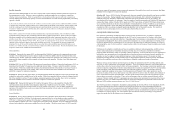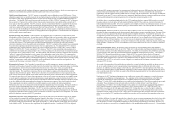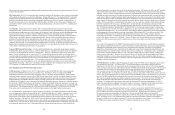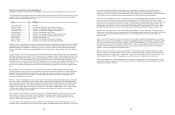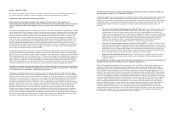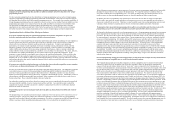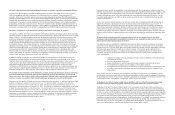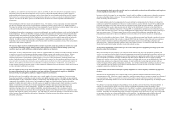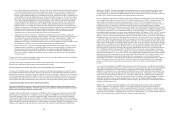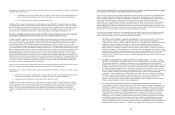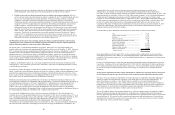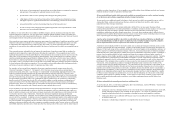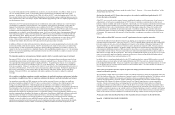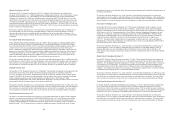Dish Network 2012 Annual Report Download - page 21
Download and view the complete annual report
Please find page 21 of the 2012 Dish Network annual report below. You can navigate through the pages in the report by either clicking on the pages listed below, or by using the keyword search tool below to find specific information within the annual report.
30
30
In the event of a failure or loss of any of our satellites, we may need to acquire or lease additional satellite capacity
or relocate one of our other satellites and use it as a replacement for the failed or lost satellite, any of which could
have a material adverse effect on our business, financial condition and results of operations. Such a failure could
result in a prolonged loss of critical programming or a significant delay in our plans to expand programming as
necessary to remain competitive. A relocation would require FCC approval and, among other things, a showing to
the FCC that the replacement satellite would not cause additional interference compared to the failed or lost satellite.
We cannot be certain that we could obtain such FCC approval. If we choose to use a satellite in this manner, this
use could adversely affect our ability to satisfy certain operational conditions associated with our authorizations.
Failure to satisfy those conditions could result in the loss of such authorizations, which would have an adverse effect
on our ability to generate revenues.
Our owned and leased satellites are subject to construction, launch, operational and environmental risks that
could limit our ability to utilize these satellites.
Construction and launch risks. A key component of our business strategy is our ability to expand our offering of
new programming and services. To accomplish this goal, we need to construct and launch satellites. Satellite
construction and launch is subject to significant risks, including construction and launch delays, launch failure and
incorrect orbital placement. Certain launch vehicles that may be used by us have either unproven track records or
have experienced launch failures in the recent past. The risks of launch delay and failure are usually greater when
the launch vehicle does not have a track record of previous successful flights. Launch failures result in significant
delays in the deployment of satellites because of the need both to construct replacement satellites, which can take
more than three years, and to obtain other launch opportunities. Significant construction or launch delays could
materially and adversely affect our ability to generate revenues. If we were unable to obtain launch insurance, or
obtain launch insurance at rates we deem commercially reasonable, and a significant launch failure were to occur, it
could impact our ability to fund future satellite procurement and launch opportunities.
x In addition, the occurrence of future launch failures for other operators may delay the deployment of our
satellites and materially and adversely affect our ability to insure the launch of our satellites at
commercially reasonable premiums, if at all. Please see further discussion under the caption “We generally
do not carry commercial insurance for any of the in-orbit satellites that we use, other than certain satellites
leased from third parties, and could face significant impairment charges if one of our satellites fails”
below.
Operational risks. Satellites are subject to significant operational risks while in orbit. These risks include
malfunctions, commonly referred to as anomalies that have occurred in our satellites and the satellites of other
operators as a result of various factors, such as satellite manufacturers’ errors, problems with the power systems or
control systems of the satellites and general failures resulting from operating satellites in the harsh environment of
space.
Although we work closely with the satellite manufacturers to determine and eliminate the cause of anomalies in new
satellites and provide for redundancies of many critical components in the satellites, we may experience anomalies
in the future, whether of the types described above or arising from the failure of other systems or components.
Any single anomaly or series of anomalies could materially and adversely affect our operations and revenues and
our relationship with current customers, as well as our ability to attract new customers for our pay-TV services. In
particular, future anomalies may result in the loss of individual transponders on a satellite, a group of transponders
on that satellite or the entire satellite, depending on the nature of the anomaly. Anomalies may also reduce the
expected useful life of a satellite, thereby reducing the channels that could be offered using that satellite, or create
additional expenses due to the need to provide replacement or back-up satellites. You should review the disclosures
relating to satellite anomalies set forth under Note 8 in the Notes to our Consolidated Financial Statements in Item
15 of this Annual Report on Form 10-K.
31
31
Environmental risks. Meteoroid events pose a potential threat to all in-orbit satellites. The probability that
meteoroids will damage those satellites increases significantly when the Earth passes through the particulate stream
left behind by comets. Occasionally, increased solar activity also poses a potential threat to all in-orbit satellites.
Some decommissioned satellites are in uncontrolled orbits that pass through the geostationary belt at various points,
and present hazards to operational satellites, including our satellites. We may be required to perform maneuvers to
avoid collisions and these maneuvers may prove unsuccessful or could reduce the useful life of the satellite through
the expenditure of fuel to perform these maneuvers. The loss, damage or destruction of any of our satellites as a
result of an electrostatic storm, collision with space debris, malfunction or other event could have a material adverse
effect on our business, financial condition and results of operations.
We generally do not carry commercial insurance for any of the in-orbit satellites that we use, other than certain
satellites leased from third parties, and could face significant impairment charges if one of our satellites fails.
Generally, we do not carry launch or in-orbit insurance on the owned satellites we use. We currently do not carry
in-orbit insurance on any of our satellites, other than certain satellites leased from third parties, and generally do not
use commercial insurance to mitigate the potential financial impact of launch or in-orbit failures because we believe
that the cost of insurance premiums is uneconomical relative to the risk of such failures. If one or more of our in-
orbit satellites fail, we could be required to record significant impairment charges.
We may have potential conflicts of interest with EchoStar due to our common ownership and management.
Questions relating to conflicts of interest may arise between EchoStar and us in a number of areas relating to our
past and ongoing relationships. Areas in which conflicts of interest between EchoStar and us could arise include, but
are not limited to, the following:
Cross officerships, directorships and stock ownership. We have certain overlap in directors and executive
officers with EchoStar, which may lead to conflicting interests. Our Board of Directors and executive
officers include persons who are members of the Board of Directors of EchoStar, including Charles W.
Ergen, who serves as the Chairman of EchoStar and us. The executive officers and the members of our
Board of Directors who overlap with EchoStar have fiduciary duties to EchoStar’s shareholders. For
example, there is the potential for a conflict of interest when we or EchoStar look at acquisitions and other
corporate opportunities that may be suitable for both companies. In addition, certain of our directors and
officers own EchoStar stock and options to purchase EchoStar stock. Mr. Ergen owns approximately
47.5% of EchoStar’s total equity securities (assuming conversion of all Class B Common Stock into Class
A Common Stock) and beneficially owns approximately 51.3% of the EchoStar’s total equity securities
(assuming conversion of only the Class B Common Stock held by Mr. Ergen into Class A Common Stock).
Under either a beneficial or equity calculation method, Mr. Ergen controls approximately 79.5% of the
voting power of EchoStar. Mr. Ergen’s ownership of EchoStar excludes 6,646,648 shares of its Class A
Common Stock issuable upon conversion of shares of its Class B Common Stock currently held by certain
trusts established by Mr. Ergen for the benefit of his family. These trusts own approximately 7.6% of
EchoStar’s total equity securities (assuming conversion of all Class B Common Stock into Class A
Common Stock) and beneficially own approximately 14.3% of EchoStar’s total equity securities (assuming
conversion of only the Class B Common Stock held by such trusts into Class A Common Stock). Under
either a beneficial or equity calculation method, these trusts possess approximately 12.9% of EchoStar’s
total voting power. These ownership interests could create actual, apparent or potential conflicts of interest
when these individuals are faced with decisions that could have different implications for us and EchoStar.
Furthermore, Charles W. Ergen, our Chairman, and Roger Lynch, Executive Vice President, Advanced
Technologies, are employed by both us and EchoStar. These individuals may have actual or apparent
conflicts of interest with respect to matters involving or affecting each company.


